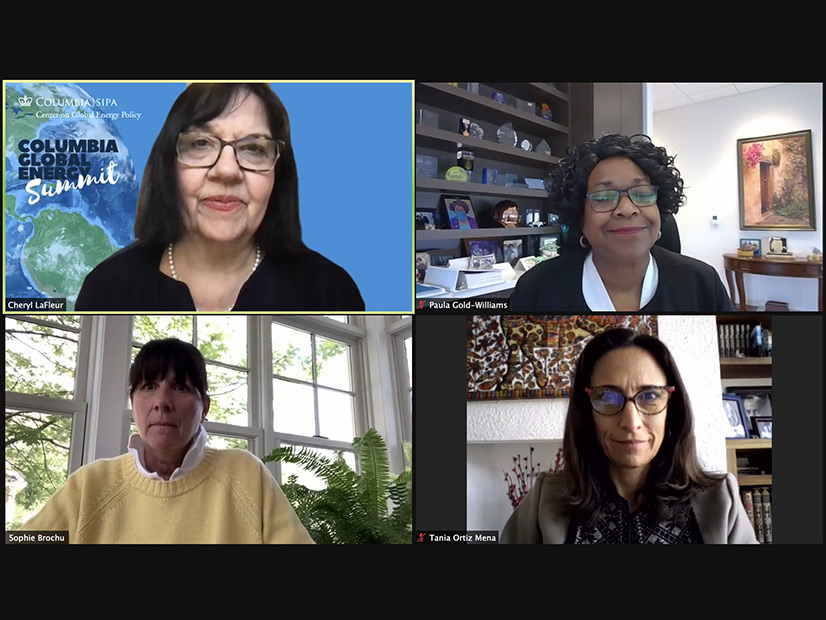Hydro-Québec CEO Sophie Brochu on Tuesday joined CPS Energy CEO Paula Gold-Williams and Tania Ortiz Mena, head of Mexico-based Sempra Energy subsidiary IEnova, to give a full North American tour of the challenges facing the power industry during the clean energy transition.
The panel, at Columbia University’s Center on Global Energy Policy (CGEP) Energy Summit, was moderated by former FERC Chair Cheryl LaFleur, now a CGEP fellow and member of the ISO-NE Board of Directors.
“If we can take care of the human beings whose jobs are threatened by the transition, it would smooth the path for larger infrastructure projects,” Brochu said. “Regional policy cannot be the summation of corporate policies, with policy first and market interests second.”
Hydro-Québec is in the process of developing one of the biggest projects in North America, the New England Clean Energy Connect, to sell power to Massachusetts. (See Renewables Boost Avangrid Q1 Earnings.) “But we have to ask who is disadvantaged by this project, who is threatened by this transition to clean energy,” Brochu said.
Exports used to be commercially driven, but now “it’s about moving the energy around at the right time of day, at the right time of the year,” Brochu said. “We see our role as to sell clean, competitive and reliable energy to New York, for example, but also to help the territories develop their own wind and solar energy, which are intermittent, that we can back up with our reservoir. So it means that in the near future, New York will sell electricity to Québec, and New England will sell electricity to Québec, and we will move that energy around.”
Cross-border Energy
Mexico’s economy is the 15th largest in the world and the country is No. 10 in population. Taking advantage of abundant U.S. natural gas is key to its manufacturing sector, which accounts for 90% of exports, Ortiz Mena said.
“We need to understand energy as a global system, not from a company perspective, not from a country perspective, and I think very much of energy from a regional perspective,” Mena said.
In North America, people talk about regional integration, but they very rarely talk about energy integration, she said.
“We developed the first ever cross-border wind generation facility right, and we’re sending wind power into California,” Mena said. Another example is a gas liquefaction plant on the west coast of Mexico to take natural gas by pipeline from Texas and ship it to Asian markets.
However, it’s becoming more difficult to build major infrastructure in Mexico, especially linear, and “we need to address that directly, which in some cases means compensating people and mitigating damages,” Mena said. “We need partnership with the communities.”
Seventy percent of Mexico’s natural gas is imported from Texas, and supplies were disrupted during the February winter storm, but “the future is electric and we need to invest in transmission, which Mexico has underinvested in for many years,” Mena said.
Electric Island
Texas exports natural gas, but “on the electric side, we’re like an island, and it’s controversial,” Gold-Williams said. “It caused some challenges in terms of our inability to push power back and forth between all across the nation, but ultimately we do have to think more about integration and get past some of the very complex issues around policy. …
“I know all the merits of solar and wind … and I don’t think you can effectively supply power to any community without thinking about that storage component,” Gold-Williams said. “The one thing we learned in Texas in February was that our winter peak has now grown to be more impactful than our summer peak. … We’re constantly trying to take heat off of plants, and we are constrained by the types of plants that function well in our hot conditions. Ultimately, you’re not going to expect wind and solar to be your primary producers in winter.”
Texas is an energy-only market, which worked to the state’s advantage for decades, but it doesn’t send signals that are preventative and get in front of growth, she said.
“As it’s pushing prices down most of the year, it grabs scarcity pricing, so it’s looking for stress situations all the time,” Gold-Williams said. “People will tell you that is how we incent people to make investments in infrastructure, but the flaw is that the system can only handle so much of that scarcity pricing. … Five days of scarcity pricing sent the absolute wrong signal in the middle of a declared disaster … and that’s when we realized that the whole design was broken.”




